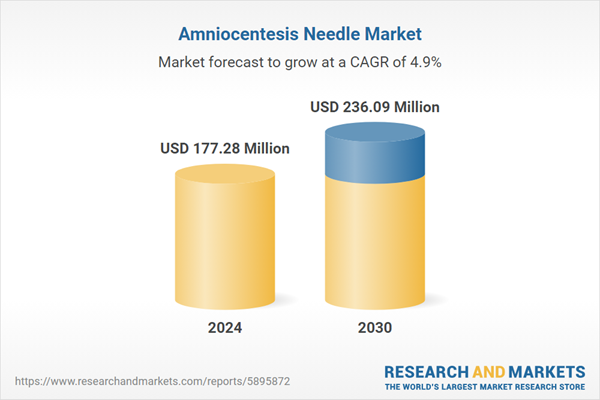Speak directly to the analyst to clarify any post sales queries you may have.
10% Free customizationThis report comes with 10% free customization, enabling you to add data that meets your specific business needs.
As awareness grows around the importance of early and accurate prenatal testing, demand for amniocentesis procedures - and by extension, amniocentesis needles - is on the rise. Increasing acceptance of prenatal diagnostics, supported by educational initiatives and healthcare advancements, is boosting market growth. Moreover, ongoing innovations in needle design and functionality, driven by manufacturer competition, are enhancing safety, precision, and cost-efficiency. Despite rising interest in non-invasive alternatives, amniocentesis remains a gold standard diagnostic procedure, ensuring sustained relevance for amniocentesis needle solutions.
Key Market Drivers
Increasing Maternal Age Worldwide
The upward trend in maternal age across the globe is significantly influencing demand for prenatal diagnostic procedures like amniocentesis. In countries such as the United States and Germany, the average age of first-time mothers has steadily increased, resulting in a higher number of pregnancies classified as high-risk. This demographic shift correlates with an elevated incidence of chromosomal abnormalities, including Down syndrome and Trisomy 18, particularly in women over 35.As these pregnancies necessitate more thorough prenatal diagnostics, the use of amniocentesis - and consequently, specialized needles for the procedure - becomes increasingly common. In developed nations like Italy, Spain, and South Korea, where the average maternal age is nearing or surpassing 32 years, the demand for accurate and safe diagnostic tools is surging. This global trend toward delayed parenthood, fueled by social and economic factors such as education, career focus, and access to fertility treatments, is a critical driver of growth in the amniocentesis needle market.
Key Market Challenges
Alternative Screening Methods
The growing adoption of alternative screening methods, particularly non-invasive prenatal testing (NIPT), presents a challenge for the amniocentesis needle market. NIPT offers high accuracy in detecting chromosomal abnormalities by analyzing cell-free fetal DNA through a maternal blood sample, reducing the need for invasive testing. These methods are preferred by many expectant parents due to their safety and comfort, as they eliminate the small but real risk associated with amniocentesis. However, while NIPT provides a reliable screening option, it does not deliver a definitive diagnosis, for which amniocentesis remains essential. The increasing use of NIPT may reduce the overall frequency of amniocentesis procedures, impacting the demand for related medical tools, including needles. Nonetheless, in cases requiring confirmation or where detailed genetic analysis is necessary, amniocentesis continues to be indispensable, maintaining its critical role in high-risk pregnancies.Key Market Trends
Rising Adoption of Non-Invasive Prenatal Testing (NIPT)
Non-Invasive Prenatal Testing (NIPT) is gaining traction as a preferred screening method, significantly shaping the dynamics of the amniocentesis needle market. NIPT enables early detection of chromosomal abnormalities using a maternal blood sample, offering a non-invasive alternative to traditional diagnostic methods. This trend reflects a growing preference for safer, less intrusive prenatal assessments.The appeal of NIPT lies in its ability to deliver accurate results with no risk of complications, enhancing patient comfort and compliance. While this shift may reduce the frequency of invasive procedures like amniocentesis, it's important to note that NIPT is a screening - not diagnostic - tool. Therefore, when definitive diagnosis is necessary, especially in high-risk pregnancies, amniocentesis remains a critical follow-up procedure. As such, the adoption of NIPT is transforming prenatal care but continues to position amniocentesis as an essential diagnostic pathway for comprehensive fetal health evaluation.
Key Market Players
- Becton Dickinson and Company
- The Cooper Companies, Inc.
- Cook Medical Incorporated
- RI.MOS. srl
- Medtronic Plc
- Somatex Medical Technologies
- COOK Medical
- Smiths Medical
- Biopsybell
- IMD
Report Scope:
In this report, the Global Amniocentesis Needle Market has been segmented into the following categories, in addition to the industry trends which have also been detailed below.Amniocentesis Needle Market, By Type:
- 100 to 150 mm Needles
- Larger Than 150 mm Needles
- Smaller Than 100 mm Needles
Amniocentesis Needle Market, By Procedure:
- Amniocentesis Procedures
- Amnioreduction Procedures
- Fetal Blood Transfusion Procedures
- Amnioinfusion Procedures
- Cordocentesis Procedures
Amniocentesis Needle Market, By Region:
- North America
- United States
- Canada
- Mexico
- Europe
- France
- United Kingdom
- Italy
- Germany
- Spain
- Asia-Pacific
- China
- India
- Japan
- Australia
- South Korea
- South America
- Brazil
- Argentina
- Colombia
- Middle East & Africa
- South Africa
- Saudi Arabia
- UAE
Competitive Landscape
Company Profiles: Detailed analysis of the major companies present in the Global Amniocentesis Needle Market.Available Customizations:
With the given market data, the publisher offers customizations according to a company's specific needs. The following customization options are available for the report.Company Information
- Detailed analysis and profiling of additional Market players (up to five).
This product will be delivered within 1-3 business days.
Table of Contents
Companies Mentioned
- Becton Dickinson and Company
- The Cooper Companies, Inc.
- Cook Medical Incorporated
- RI.MOS. srl
- Medtronic PLC
- Somatex Medical Technologies
- COOK Medical
- Smiths Medical
- Biopsybell
- IMD
Table Information
| Report Attribute | Details |
|---|---|
| No. of Pages | 188 |
| Published | April 2025 |
| Forecast Period | 2024 - 2030 |
| Estimated Market Value ( USD | $ 177.28 Million |
| Forecasted Market Value ( USD | $ 236.09 Million |
| Compound Annual Growth Rate | 4.8% |
| Regions Covered | Global |
| No. of Companies Mentioned | 10 |









